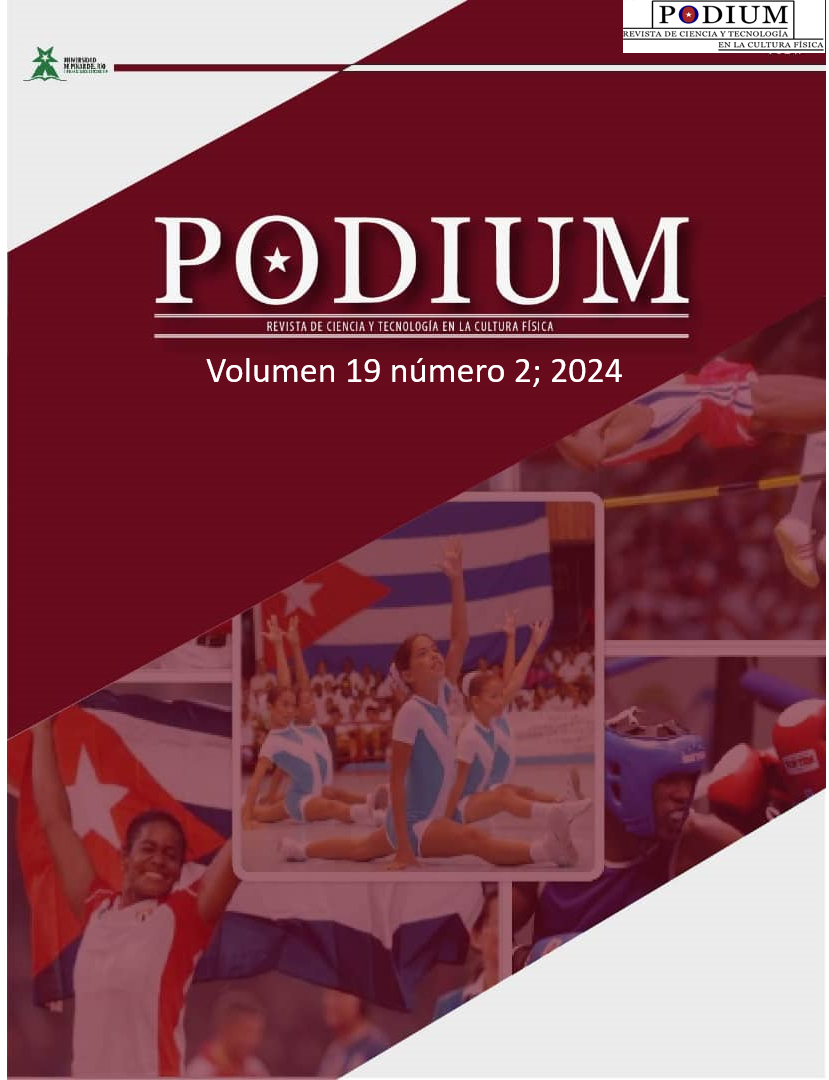Dança afro-equatoriana: alternativa metodológica para la inclusão de alunos com hiperatividade na Educação Física
##plugins.themes.bootstrap3.article.main##
Resumo
Reconhece-se que a dança afro-equatoriana é um vínculo de ligação com os ancestrais e a identidade, e proporciona uma educação em movimento que facilita, por sua vez, o desenvolvimento de valores educativos em torno do tratamento do corpo; Isso favorece a motivação para a prática de atividade física continuada. O objetivo da pesquisa reside em propor a dança afro-equatoriana como alternativa metodológica para a inclusão de alunos com hiperatividade e está contextualizada no décimo ano, com um total de 35 alunos, e uma amostra de um aluno com transtorno de déficit de atenção e hiperatividade, da Escola Básica Superior da Unidade Educacional "José Otilio Ramírez Reina", província de Esmeraldas no Equador. O estudo baseou-se na abordagem quanti-qualitativa e no método dialético-materialista; Métodos do nível teórico como histórico-lógico e análise-síntese e do nível empírico, análise documental, observação e levantamento, foram utilizados para interpretar as derivações obtidas em cada etapa que passou do nível exploratório, descritivo, até chegar a uma explicação do fenômeno investigado. Os resultados revelam o insuficiente reconhecimento da dança afro-equatoriana para a inclusão de alunos com esse transtorno, bem como a limitada produção científica relacionada ao tema. Do estudo realizado concluiu-se que a dança afro-equatoriana constitui um caminho expedito para um melhor conhecimento, diversão e preservação da identidade destes alunos.
Downloads
##plugins.themes.bootstrap3.article.details##

Este trabalho encontra-se publicado com a Creative Commons Atribuição-NãoComercial 4.0.
Referências
Alcivar-Alcívar, J. C., and Zambrano-Montes LC (2021). Interdisciplinary teaching strategies in meaningful learning for students in single-teacher schools. Dom. Cien., ISSN: 2477-8818, 7(6), October-December 2021, pp. 1144-1165 http://dominiodelasciencias.com/ojs /index.php/es/index
Castillo-Paredes, A., Montalva Valenzuela, F., and Nanjarí Miranda, R. (2021). Physical Activity, Physical Exercise and Quality of Life in children and adolescents with attention deficit and/or hyperactivity disorder. Habanera Journal of Medical Sciences, 20 (5), e3714. https://revhabanera.sld.cu/index.php/rhab/article/view/3714/2963
Conesa -Ros, E., and Angosto, S. (2017). Body expression and dance in secondary and high school physical education. Sports Psychology Notebooks, 17(2), 111120. https://revistas.um.es/cpd/article/view/301961
Dallal, A. (2020). The elements of dance. Mexico: UNAM, General Directorate of Publications and Editorial Development. https://books.google.com.cu/books/about /Los_elementos_de_la_danza.html?id=vUjcDwAAQBAJ&source=kp_book_description&redir_esc=y
Hernández Sampieri, R., Fernández Collado, C., and Baptista Lucio, P. (2018). Research methodology (Vol. 4, pp. 310-386). Mexico: McGraw-Hill Interamericana.
Gómez Valdés, A., Planes Rivera, D. de la C., and Gómez Ledesma, Y. (2019). Methodological actions to contribute to the Inclusive Physical Education process: An approach to the topic. Mendive Magazine, 17(1), 84-96. http://scielo.sld.cu/scielo.php?script=sci_abstract&pid=S181576962019000100084&lng=es&nrm=iso&tlng=es
Hernández-Beltrán, V., González-Coto, VA, Gámez-Calvo, L., Luna-González, J., and Gamonales, JM (2022). Proposal for a teaching unit for Physical Education: "sports orientation as an inclusion tool for students with ADHD." E-Motion: Journal of Education, Motor Skills and Research, (19), 60-81. https://doi.org/10.33776/remo.vi19.7220
Ibarra E., Aracelly L., and Rivera, AM (2019). Formative and identity potentials of Colombian dance. Conrado, 15 (68), 135-141. Epub September 2, 2019. http://scielo.sld.cu/scielo.php?script=sci_arttext&pid=S1990-86442019000300135&lng=es&tlng=es .
Quintero-Olivas, DK, Romero Pérez, EM, and Hernández- Murúa , JA (2021). Quality of family life and childhood ADHD. Multidisciplinary perspective from physical education and social work. Physical Activity Sciences Magazine, 22 (1). https://doi.org/10.29035/rcaf.22.1.1
Matos, M., Smith, E. and Muñoz A. (2020). Folk dances: a way of learning and educating from a sociocultural perspective. 2020, Retos, 38, 739-744 © Copyright: Spanish Federation of Physical Education Teachers' Associations (FEADEF) ISSN: Printed edition: 1579-1726. https://recyt.fecyt.es/index.php/retos/article/view/73725
Muntaner-Guasp, J., Mut-Amengual, B. and Pinya -Medina, C. (2022). Active methodologies for the implementation of inclusive education. Educare Electronic Magazine, 26(2), 85-105. https://www.scielo.sa.cr/scielo.php?script=sci_arttext&pid=S140942582022000200085
Olave , K.J. (2022). The Afro-Esmeralda dance as a symbol of resistance of the black maroon. Obtained from University of the Arts: https://dspace.uartes.edu.ec/handle/123456789/1048
Paredes, AC, Lago, AC, Gacitúa, CN, Pacheco, RGP, and Wilkomirsky , A. (2023). Psicoballet, a clinical tool for social integration with benefits at a biopsychosocial level: A review of the literature. Challenges: new trends in physical education, sports and recreation. Retos Magazine, (47), 831-841 https://recyt.fecyt.es/index.php/retos/article/view/94228
Páez Basabe , M., Arcia Melgarejo, S., Escalona García, C., Vargas Géliga, E., and Darias Ávila, N. (2022). Brochure of compensatory corrective pre-sports games for students with intellectual disabilities. Podium. Podium Magazine , 17(3), 1006-1017 https://podium.upr.edu.cu/index.php/podium/article/view/1334
Rivera, AL, and Remón, Á. LC (2017). Benefits of physical-sports activity in boys and girls with ADHD. EmásF: digital magazine of physical education, (44), 63-78. https://dialnet.unirioja.es/servlet/articulo?codigo=5807535
Soler, NS, and Ramírez, FG (2023). Physical Education teachers in active v/s in training: level of knowledge about Attention Deficit and Hyperactivity Disorder in schoolchildren. Challenges: new trends in physical education, sports and recreation, (50), 421-427. https://dialnet.unirioja.es/servlet/articulo?codigo=9063942


